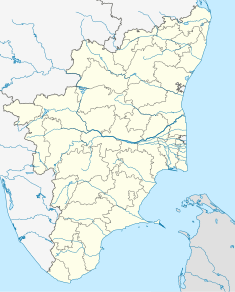
Namakkal is a city and the headquarters of Namakkal district, Tamil Nadu. It is the first ISO 14001-2004 certified municipality in Asia for environmental management, specifically the provision and maintenance of water supply, solid waste and sewage management, town planning, lighting and other social services. Namakkal is known as the Egg City due to its large egg production and Transport city.

Tamil Jains are ethnic-Tamils from the Indian state of Tamil Nadu, who practice Jainism,. The Tamil Jain is a microcommunity of around 85,000 .They are predominantly scattered in northern Tamil Nadu, largely in the districts of Tiruvannamalai, Kanchipuram, Vellore, Villupuram, Ranipet and Kallakurichi. Early Tamil-Brahmi inscriptions in Tamil Nadu date to the third century BCE and describe the livelihoods of Tamil Jains. Samaṇar wrote much Tamil literature, including the important Sangam literature, such as the Nālaṭiyār, the Cilappatikaram, the Valayapathi and the Civaka Cintamani. Three of the five great epics of Tamil literature are attributed to Jains.

Madurantakam is the southernmost suburb of Chennai city and a municipality in Chengalpattu district in the Indian state of Tamil Nadu. The town is known for the artificial and second largest lake in Tamil Nadu, the Madurantakam lake. It is said to have been built by the Chola King Uttama Chola, also called as Maduranthaka, during his reign. It is also home to the Eri-Katha Ramar Temple. As of 2011, the town had a population of 30,796.
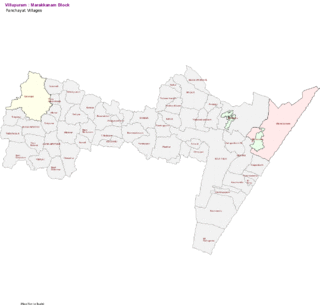
Marakkanam is a coastal panchayat town & Taluk in Viluppuram district in the Indian state of Tamil Nadu. It is well connected to the state capital Chennai and the nearby union territory of Puducherry by the East Coast Road. To the west, Marakkanam is connected to the town of Tindivanam by the SH-134. Marakkanam is situated on the declared National Waterways NW-4. On materialisation of National Waterways NW-4, Marakkanam will be connected to two states Andhra Pradesh (Kakinada) and Puducherry through north and south of Buckingham Canal.
Tindivanam is a municipality in Viluppuram district in the Indian state of Tamil Nadu. It is the second largest town in Villupuram District after the headquarters town Villupuram. Important roads from north to south Tamil Nadu pass through Tindivanam and similarly from west to east.

The earliest undisputed deciphered epigraphy found in the Indian subcontinent are the Edicts of Ashoka of the 3rd century BCE, in the Brahmi script.

Tiruchirappalli Rock Fort, locally known as Malaikottai, is a historic fortification and temple complex built on an ancient rock. It is located in the city of Tiruchirappalli, on the banks of river Kaveri, Tamil Nadu, India. It is constructed on an 83 metres (272 ft) high rock. There are two Hindu temples inside, the Ucchi Pillayar Temple, Rockfort and the Thayumanaswami Temple, Rockfort. Other local tourist attractions include the famous Pallava-era Ganesha temple and the Madurai Nayak-era fort. The fort complex has witnessed fierce battles between the Madurai Nayakas and Adil Shahi dynasty of Bijapur, Carnatic region and Maratha Imperial forces. The fort played an important part during the Carnatic Wars, helping lay the foundations of the British Empire in India. The Rockfort is the most prominent landmark of the city.
Tamil Nadu is the southernmost state of India located on south-eastern coast of the Indian peninsula. The state is straddled by Western Ghats and Eastern Ghats to the west and north and the waters of Bay of Bengal and Andaman Sea on the other two sides. It is the home of the Tamil people, who speak Tamil language, one of the oldest surviving languages. The capital and largest city is Chennai which is known as the "Gateway to South India". As of 2021, the state is the most visited and has received the most number of tourists amongst all states of India.

The Sambuvarayar chieftains once ruled the Tondaimandalam region of South India. Among them was Edirili Chola Sambhuvaraya, a vassal under Rajadhiraja Chola II and Kulotunga Chola III, who ruled the northern part of Tondaimandalam, now comprising the districts of Vellore, Tiruvannamalai, Kancheepuram, Cuddalore, Tiruvallur, Nellore, and Chittoor. Later during the 14th century when the Telugu Cholas, Hoysala and Pandya kingdoms went into decline, the Sambuvarayas ruled their regions independently. Two chiefs of the family namely, Venrumankonda Sambuvaraya and Rajanarayana Sambuvaraya, issued records in their own regnal years.
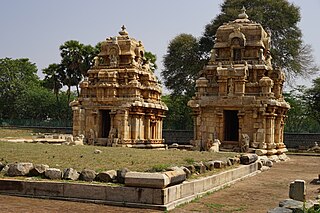
Moovar Koil or "The Three temples" is a Hindu temple complex situated in the village of Kodumbalur, 36 kilometres from Pudukkottai in Tamil Nadu, India. These temples were constructed by the Chola feudatory and Irukkuvel chieftain Boothi Vikramakesari as per the inscription. Only two of the three temples have managed to survive. The place was ruled by Irukkuvel chieftains. Kodumbalur was also the site of a fierce battle between the Pandyas and the Pallavas.
Jambai is a 1 km2 (0.39 sq mi) village in Tirukkoyilur taluk in Kallakurichi district in the Indian state of Tamil Nadu. The major occupation of the people living at this place is agriculture and handloom. In 2011, it had a population of 2,000 people.

Jainism has an extensive history in the Indian state of Tamil Nadu, although practiced by a minority of Tamils in contemporary times. According to the 2011 India Census, Jains represent 0.12% of the total population of Tamil Nadu, and are of the Digambara sect. Tamil Jains are primarily concentrated in northern Tamil Nadu, in the districts of Madurai, Viluppuram, Kanchipuram, Vellore, Tiruvannamalai, Cuddalore and Thanjavur.
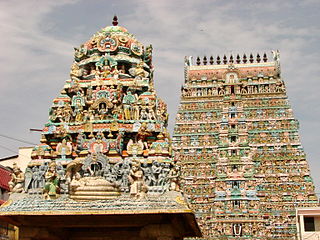
Tamil Nadu is known for its ancient temple architecture. Nearly 33,000 ancient temples, many at least 800 to 2000 years old, are found scattered all over Tamil Nadu. As per Tamil Nadu Hindu Endowments Board, there are 38,615 temples. Most of the largest Hindu Temples are located in Tamil Nadu. Studded with complex architecture, a variety of sculptures, and rich inscriptions, the temples remain the very essence of the culture and heritage of Tamil land, with historical records dating back to at least 3,000 years.

Padalathri Narasimhar Temple or Narasimhar Temple is dedicated to Hindu god Vishnu (Narasimha) located in Singaperumal Koil, near Chennai City, in the South Indian state of Tamil Nadu. Constructed as rock-cut architecture, dedicated to Vishnu, who is worshipped as Narasimhar, and his consort Lakshmi as Ahobilavalli, the temple was built by the Pallavas during the 8th century. Earlier in Kanchipuram district, it is now under Chengalpattu district. The temple is Classified one among the 108 Abhimana Kshethram of Vaishnavate tradition.
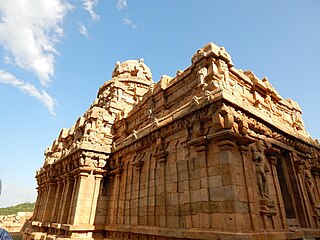
Vijayalaya Choleeswaram in Narthamalai, a panchayat town in Pudukottai district in the South Indian state of Tamil Nadu, India, is a temple dedicated to the Hindu god Shiva, Vishnu and houses the 8th century Jaina Abode. The temple is considered one of the oldest stone temples in South India. The other portions of Narthamalai houses the 8th century Jaina Abode, the Aluruttimalai Jain Caves. The Temple is Constructed in the Dravida style and rock cut architecture, the temple is believed to have been built during the 9th century by Mutharaiyar dynasty kings, the cardinals of Pallavas, with later expansion from the Cholas. The rock-cut architecture is an early example of Cholan Art, continuing the tradition of the Pallavas.

Kunnandarkoil Cave Temple in Kunnandarkoil, a village in Pudukottai district in the South Indian state of Tamil Nadu, is dedicated to the Hindu god Shiva. Constructed in Rock-cut architecture, the temple is believed to have been built during the 8th century by Muttaraiyar kings, the cardinals of Pallavas, with later expansion from the Vijayanagar Empire. The rock-cut architecture in the temple is a specimen of the late Pallava Art and an early example of Chola Art. The temple has various inscriptions from Cholas, Chalukyas, Pandyas and Vijayanagar Empire. The temple is considered one of the oldest stone temples in South India. The temple is maintained and administered by Department of Archaeological Survey of India as a protected monument.
Endiyur is a village panchayat located in Tindivanam, in the Villupuram district of Tamil-Nadu, India. The native language of the village is Tamil. The village is connected to nearby places through SH-134. The nearest railway station is Tindivanam which is 5 km from the village. Puducherry is 32.8 km from Endiyur. The village has a Draupadi Amman temple.
Natana Kasinthan is an Indian historian, archaeologist, author and epigraphist who is known for his work on inscriptions of Tamil Nadu. He served as the Director of the Tamil Nadu Archaeology Department, Government of Tamil Nadu. He is credited for reviving the inscriptions relating to early Tamil civilizations.

This is a list of archaeological artefacts and epigraphs which have Tamil inscriptions. Of the approximately 100,000 inscriptions found by the Archaeological Survey of India in India, about 60,000 were in Tamil Nadu
